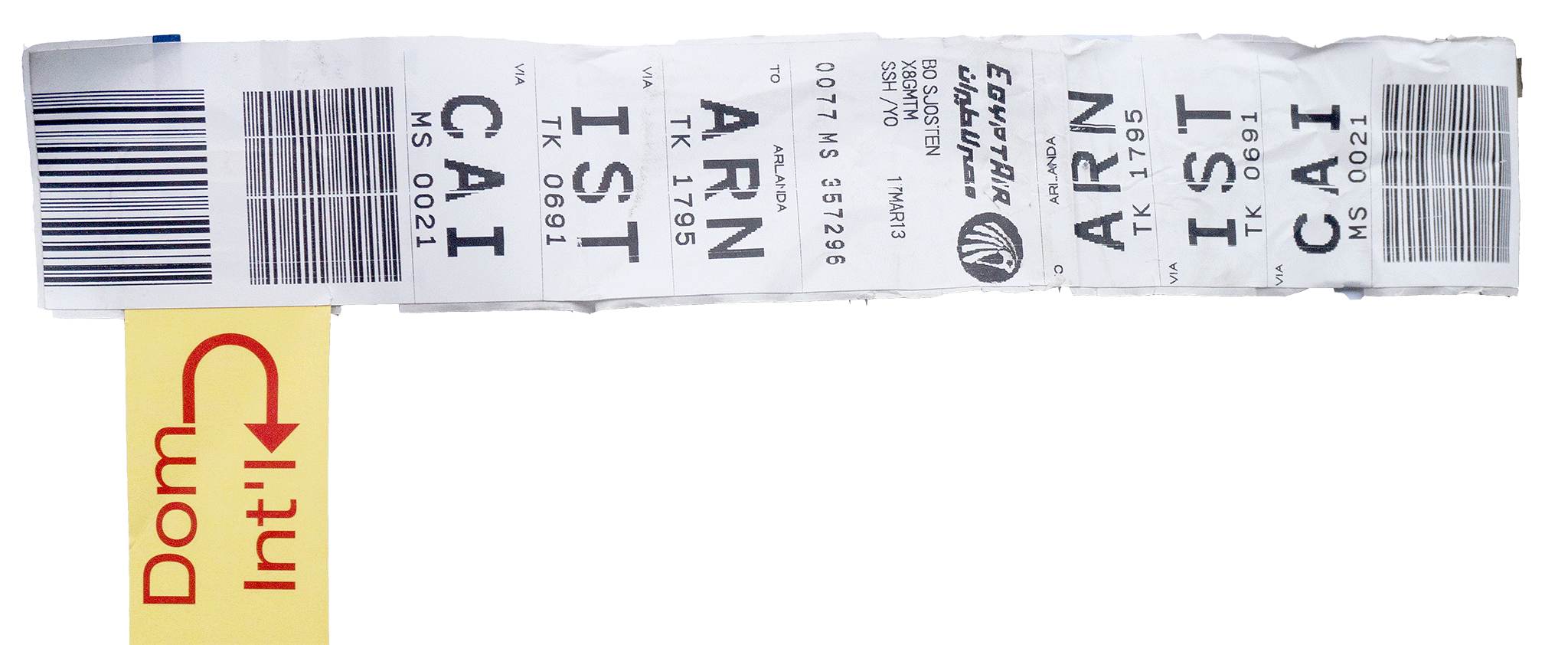Stockholm Arlanda Airport, a cold winter morning at 7.30 AM. The dark side of any golf trip, the early morning departure. We are on our way to Tunisia, via Frankfurt. SK3611 is our flight number.
To speed up our check-in we called Scandinavian Airlines (SAS) ahead of time to pre-pay the golf bag fees. “We’re sorry, that’s not possible” is the answer from SAS. “Our system does not have that capability. You will have to pay at the airport”. This is in spite of the SAS home page, which clearly states that “A golf bag may contain a maximum of 14 clubs, 12 golf balls, and a pair of golf shoes”, that we should pre-register the golf bag with the airline, and that there will be an extra fee if we exceed the maximum number of allowable checked-in bags. In a different part of the website, it says “Golf bag, max weight 23 kg, 30 euro (note 1) for travel within Europe”. No mention of the number of clubs here, just max weight. We are already confused, and the agent on the phone is of little help.
We are a group of four golfers going to Tunisia, two from Sweden, one from Finland, and one from Norway. We are all checking in separately.
I am the first one to check-in at Stockholm airport. I only have my golf bag, plus a carry-on. No problems, no extra fees, except that I have to retrieve my golf bag in Frankfurt, and re-check it with Tunis Air. But that should not be a problem, golf bags are free on Tunis Air.
My Swedish friend has both a suitcase and a golf bag.
“50 Euro” he is told.
“But SAS says 30 euro?”
“You’re traveling with Lufthansa, they charge 50 euro” (note 2)
In spite of the flight number being SK3611 (SK is the SAS flight code), he has to pay the Lufthansa fee for the golf bag. Turns out the flight is a codeshare, and Lufthansa is the airline actually operating it. However, my friend manages to check his golf bag all the way through to Tunis, something that was “impossible” just 15 minutes earlier when I checked in.
Our Finnish friend checks in in Helsinki. He is also traveling with Lufthansa to Frankfurt. In spite of having both a suitcase and a golf bag, he doesn’t have to pay a fee. But his has to retrieve the baggage in Frankfurt and re-check in.
Finally, our Norwegian friend, who checks in in Oslo. He has to pay 45 euro and re-check his bags in Frankfurt, getting the worst deal of the four of us.
The rest of the trip is uneventful. No problems checking in in Frankfurt, and Tunis Air doesn’t charge us any fees for the golf bags.

Return trip
After a very pleasant week in Tunisia, it is time to return to Scandinavia. Same route, Tunis – Frankfurt – Stockholm/Oslo/Helsinki.
We are all in the same check-in line. I am the first to check-in. My golf bag is checked through all the way to Stockholm, with at no extra cost. But I have to know the airport code for the airport in Stockholm. Fortunately, I know the code (ARN), and my bag is properly tagged and sent on its way. In addition to the golf equipment, it is now filled with everything that didn’t fit in the carry-on and weighs in at 21.5 kg. No problem.
However, both my Norwegian and Finnish friends are not able to get their bags checked through, so they will have to re-check them in Frankfurt.
Our Finnish friend does not have the same luck in Frankfurt. Lufthansa demands 50 euro for the Frankfurt – Helsinki leg of the trip. When he protests, they threaten to charge him an extra 50 euro since he didn’t pay on the way to Tunisia… talk about smooth and friendly customer service.
Our Norwegian friend is also charged in Frankfurt. This time he is charged 30 Euro because now SAS is the actual carrier.
So in spite of SAS and Lufthansa both being part of Star Alliance, they have different rules for golf bags. Something that can be quite confusing, since it is not apparent from the flight number which airline is actually the carrier on the route. One has to wonder what the customer advantage of an Alliance is when the members cannot even agree on something so basic as baggage restrictions and fees?
A few more examples
- Three people with golf bags, traveling to Munich with Lufthansa, and then connecting with Lufthansa’s regional partner airline to Trieste, Italy. One golf bag didn’t make it, probably due to weight problems on the fully booked smaller regional turbo-prop, although no one would admit to that being the problem. A dozen other passengers also didn’t get their baggage, resulting in the claims procedure in Trieste taking over two hours. The bag arrives 36 hours later.
- Two people, traveling from Sharm-el-Sheik, Egypt to Stockholm, with two stops on two different airlines, Egypt Air and Turkish Airlines. This also included a domestic to international transfer in Cairo, and a second change of aircraft in Istanbul. Both golf bags are checked all the way through, and both make it without any problems.

- One person, traveling on a non-stop Air France flight from Paris CDG to Stockholm. Checked in two hours before flight departure, checked and double checked the baggage tags. The golf bag still didn’t make it, and arrived 30 hours later.
- One person, traveling on Air Berlin to Mallorca, with a transfer in Berlin. Flight to Berlin is late, and the time to connect at Tegel Airport in Berlin is only five minutes. Against all odds, the golf bag makes it all the way. On the return trip, the flight is again late, this time missing the connection, forcing an overnight hotel stay in Berlin. The golf bag stays checked-in, but when the trip concludes with a non-stop flight to Stockholm the following day the bag doesn’t make it, and arrives 40 hours late.
Take-home lessons
Traveling with a golf bag is not easy. In addition to confusing rules and exorbitant fees, a common problem is that the bag simply doesn’t make it to the destination. This is especially true when you have a connecting flight. And if your connecting flight is with a regional carrier, the odds of your golf bag not making it increases even more, since golf bags often are first in line to get left behind when a flight has weight problems, not uncommon with smaller aircraft on regional routes.
As golf journalists, we at GTJ travel a lot. What has worked best for us is traveling with a large carry-on plus a golf bag with a wheeled cover. So far, we haven’t run into any airline that doesn’t accept the golf bag as a substitute for a suitcase (assuming that you travel with an airline that includes one suitcase with your ticket). Up to 23 kg seems to work in most cases, except for some low-fare airlines. Since the golf equipment normally weighs around 15 kg, you can fit some extra clothes together with the golf bag in the golf cover.
The advantage of this arrangement is that with a carefully packed carry-on, you can carry all you need for a day or two of golf (shoes, glove, balls, etc), so you can play even if your bag is delayed. You can always rent golf clubs for a day or two at your destination until your golf bag shows up (which it almost always does, it is very seldom completely lost).
The disadvantage is of course a rather large carry-on. But if you can find a rolling carry-on with the maximum dimensions (55 x 45 x 20 cm), you can fit in a lot. And it will fit perfectly in the overhead bin without encroaching on your fellow passengers’ space since the overhead bins are optimized for that dimension bag.

To conclude, make sure that you educate yourself in the rules of the airline you travel with. As you can see from the story, it is not a given that the person checking you in will be up to date on the rules, and he/she may mislead or even overcharge you. This is especially true if the airline doesn’t have its own staff at check-in, but uses a handling agent. Know the rules, and insist on your rights.
Coming up
In a future issue of Golf Travel Journal, we will do a run-down of policies and charges for golf bags by different airlines. At least what the official price list states…
Notes
Note 1: SAS has since doubled their golf bag fee, to 60 euro for a one-way trip within Europe. On a recent trip from Dublin, that was more than what my ticket cost…
Note 2: The agent over-charged. The Lufthansa fee is 30 euro within Europe, and 50 euro outside Europe. We were traveling to Tunis, which is in Africa, but Tunis Air does not charge extra for golf bags. The correct fee should have been 30 euros for the Stockholm – Frankfurt leg.






